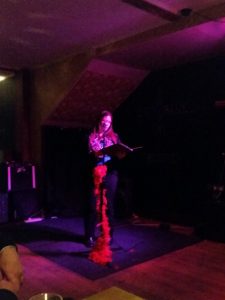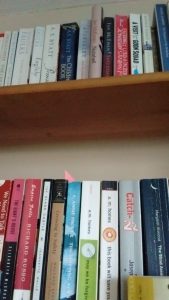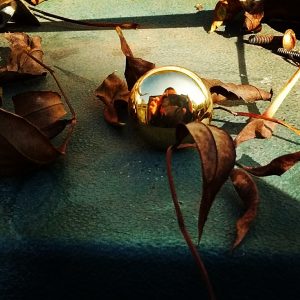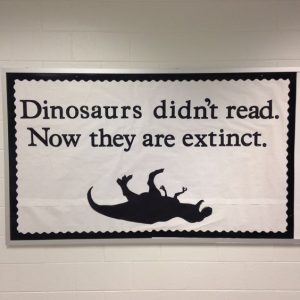This Week’s Bit of String: ‘The World’s Largest Jigsaw Puzzle’
Sweden, 1628. The country is at war with Poland, so King Gustavus Adolphus orders a mighty ship built, with holes for thirty-two cannons on each side. When each cannon hatch is opened, a carved lion’s head, mid-roar, glares out from the inside of the lifted door. The Vasa is fierce and ornate, and I can just imagine the king promising ‘fire and fury like the world has never seen before.’
But as the Vasa sets off for the very first time, the top-heavy ship starts to list, then sinks after a kilometre, dragging at least thirty to their deaths.
Over three hundred years later, the ship is located and, incredibly, salvaged. Piecing together all the bits that fell off takes twenty-five years, including twelve during which some experts focus on restoring original colours to the statues. The whole Vasa is now a museum in Stockholm.

As breathtaking as the ship is, I am also fascinated by the process of its discovery and restoration. The Vasamuseet exhibits skeletons found on the ship, and details what scientists and historians have learned from them. They’ve created digital, 3D portraits of the Vasa’s victims, based on their skulls. Turns out skulls don’t all look the same (although I got the impression they did when I visited the Catacombs in Paris). Small differences in eye socket and mouth shape and position indicate not just where those features were, but also how facial muscles connected to them, and from there offer clues to flesh out the faces.
This all made me think about story development. (Come on, any writer would.) How do we flesh ideas out into full stories?
The Idea (Skeleton)
We get ideas (when we’re lucky). Those are just the bones, washed up from the relentless tide of busy everyday life.
An idea can be a name, a phrase, an image, a what if, a combination of these. At work we’re planning a trip to a Halloween ‘frightmare,’ and it made me wonder what it’s like for those people who are paid to jump out and scare you all night long. Does that have some kind of effect on the psyche? I don’t know what the story would look like, but the what if is not migrating from my brain.
The Questions (Muscles)
We then ask questions about our idea. It’s not an interrogation, but an investigation. It’s exciting, not demanding. This forms the foundation of plotting.
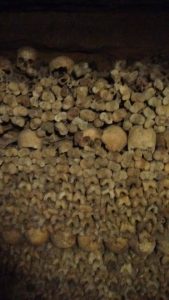
The questions tell us how it all works, so they are the muscles driving this thing. Does someone choose to take a job scaring people? Why would they make this choice? What is their everyday life like? How will this job affect it?
I had a little Twitter discussion about story development. Children’s writer Michael Mahin pointed me to his great post on planning a story around a central question. This is your ultimate What If, a little like your hook.
It’s worth noting that a muscle-bound face (if that’s a thing) would not be particularly pleasant. Don’t overthink the plotting of your story. Plot needs to be an unfolding, not a firing off of facts. Asking why is at least as important as asking what happened.
Also, questions are a great facilitator of ideas, of digging up the bones in the first place. If you’re stuck at the first stage, here are tips from Helen Taylor to generate your own writing prompts.
The Connections (Tissue)
Once we know more about our idea, we have to fit together the beginning, middle, and end of what we’re actually going to tell. Now the planning really takes off.
Among the responses I had on Twitter, quite a few people mention Post-Its or outlining to keep track of these different points. I take down various scribbles myself.
We might use music to inspire us. Julie Rea, a Scottish Book Trust winner, described almost the exact process I tend to use in her tweet: ‘Jot idea down in a pad. Listen to music with the ‘feel’ of the story, jot down more ideas. Weeks could pass. Sketch a rough outline-write!’ (I insert a few hikes, and more than enough sleepy, jolty, subconscious-jabbing bus commutes.)
Flashers’ Club and Writers HQ Cheltenham guru Alex Clark tweets about longer works like novels, ‘Plotting happens in a very ploddy, non-magical way.’ I love this phrase and have found it to be pretty accurate.
Of course, the process totally varies. As a couple of people pointed out, the original idea will often be two-fold: image plus phrase, for example. And with short stories, it often just cascades into place. Whatever you’ve read recently, whatever you’ve seen and heard, the idea acts as a magnet and pulls the most salient bits into its field.
The Actual Writing (Skin)
Then we write, my friends. A fair number of us will write anyway, and structure afterwards, at least with short stories. This bit can feel like magic, actually. I’ve been working on a story this week from an idea that came to me at 4:30 Tuesday morning. I just started writing it, and the next bits continually feed themselves to the page.
These are the moments when I feel I must be doing something right. What comes out at the end will probably need a lot of contouring, cosmetics, maybe even plastic surgery. The resulting face may not be glamorous but hopefully there will be an authenticity and more than a spark of interest to it.



